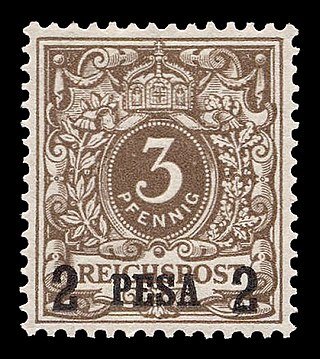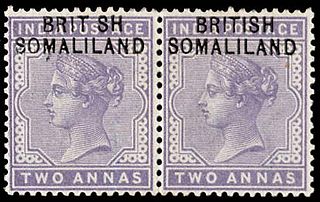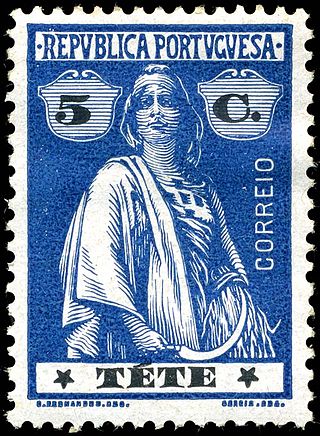You can help expand this article with text translated from the corresponding article in French. (March 2015)Click [show] for important translation instructions.
|
This is a survey of the postage stamps and postal history of Macau (or Macao).
You can help expand this article with text translated from the corresponding article in French. (March 2015)Click [show] for important translation instructions.
|
This is a survey of the postage stamps and postal history of Macau (or Macao).

The first stamps issued for Macau, appearing in 1884, used the common "Portuguese crown" design for nine values ranging from 5 to 300 reis. Later in 1884, an 80-reis value was produced as a surcharge on the 100-reis value; in 1885 an 80-reis value of the crown design went on sale. Also in 1885, five values were re-issued in new colors. Shortages of values continued through 1887, resulting in a variety of surcharges on both postage stamps and revenue stamps. [1]
New stamps in 1888 depicted Luis I with an embossed profile. Luis died soon after, and in 1894 a new series of 12 values featured a portrait of Carlos I. Also in 1894 the currency was changed to avos and rupees, 78 avos to the rupee (this would change to 100 avos to the pataca in 1913). In response leftover Luis stamps were surcharged in various avos values, in both Latin and Chinese characters, along with the word "PROVISORIO".
In 1898 both the Vasco da Gama issue of commemoratives, and a new series of Carlos designs, were all denominated in avos. Shortages of particular values were a regular occurrence from 1900 through 1910, resulting in nearly 40 types of surcharges, as well as postage due stamps pressed into regular service by overprinting obliterating bars on the "PORTEADO" and "RECEBER" text of those stamps.

In the wake of the revolution of 1910, the government overprinted stocks of the Carlos stamps with "REPUBLICA" and shipped those out to Macau. The turbulent situation required some creativity on the part of local officials, and in 1911, they produced 2a and 5a values by overprinting the new value diagonally in upper right and lower left corners of 4a and 10a stamps, then bisecting them on the diagonal. In 1913, they also applied a Republica overprint to a variety of older stamps going back to 1898.
The Ceres series of 1913 was a fresh start for all the Portuguese territories, ultimately adding up to 29 value/color combinations (up to 5 patacas) through 1924. Even so, in 1915 additional Republica overprints were needed on the surcharges of 1902 (themselves overprinted on 1888 and 1894 issues. Between 1931 and 1933, nine lesser-used values of the Ceres stamps were surcharged.
On 1 February 1934, a new definitive series used a design with an allegorical figure representing "Portugal" and Vasco da Gama's flagship São Gabriel. They were surcharged in 1941, and eight values were reprinted in 1942. The reprints were lithographed (instead of typographed as were the 1934 printings) on a thin paper, roughly perforated.
Macau participated in the Empire issue of 1938, with 17 values.
In 1948, a new definitive series consisted of 12 values with different pictorial designs depicting local scenery. Subsequent issues included many of the common design types issued for all the Portuguese territories, with some commemoratives for anniversaries in Macau. Macau's 1976 acquisition of "special territory" status gave it more autonomy in its handling of the post, and starting in 1981 it issued a variety of more-appealing designs relating to local geography and culture, generally in sets of 4-6 related designs.

The main effect of the 1999 transition to special administrative region status was a change in the inscription on the stamps: from "MACAU" along with "REPÚBLICA PORTUGUESA" in smaller print somewhere on the stamp, to "MACAU, CHINA".

This is a survey of the postage stamps and postal history of German East Africa.

On 1 January 1868, Portugal issued postage stamps for the islands of Madeira, consisting of the current stamps of Portugal overprinted "MADEIRA". Subsequent stamps were also overprinted, through 1881.

The postal history of Portuguese India goes back to the earlier days of the colony. The postal history begins with communication between the Viceroy and the Court at Lisbon soon after the conquest of Old Goa by Afonso de Albuquerque in 1510. Letters, written in triplicate, were carried by separate ships because of the hazards of the voyage. Mail was carried by an overland route, as well. The early communications of Portuguese India had an official character and the correspondence is now to be found in museums and governmental and ecclesiastical archives.

Originally mail from British Somaliland used postage stamps of Egypt, then India. In 1903, about 30 types of stamps of India were overprinted "BRITISH / SOMALILAND".

Postage stamps and postal history of the Azores surveys the postal history of the Portuguese archipelago, situated in the north Atlantic.

In 1913 and 1914, Portugal issued postage stamps specifically for Tete Province, now part of Mozambique.
Each "article" in this category is in fact a collection of entries about several stamp issuers, presented in alphabetical order. The entries themselves are formulated on the micro model and so provide summary information about all known issuers.
Each "article" in this category is a collection of entries about several stamp issuers, presented in alphabetical order. The entries are formulated on the micro model and so provide summary information about all known issuers.
Each "article" in this category is a collection of entries about several stamp issuers, presented in alphabetical order. The entries are formulated on the micro model and so provide summary information about all known issuers.

The Ceres series of Portuguese postage stamps is a definitive series depicting the Roman goddess Ceres that was issued between 1912 and 1945 in Portugal and its colonies.
The pataca was a monetary unit of account used in Portuguese Timor between 1894 and 1958, except for the period 1942–1945, when the occupying Japanese forces introduced the Netherlands Indies gulden and the roepiah. As in the case of the Macanese pataca which is still in use today, the East Timor unit was based on the silver Mexican dollar coins which were prolific in the wider region in the 19th century. These Mexican dollar coins were in turn the lineal descendants of the Spanish pieces of eight which had been introduced to the region by the Portuguese through Portuguese Malacca, and by the Spanish through the Manila Galleon trade.

The early issues from 1853 had the monarch's head, white and featureless, embossed on a coloured background. The most valuable stamps from this period are Gibbons catalogue nos 8 and 9 from the 1853 issue: the 100 reis lilacs.
This is a survey of the postage stamps and postal history of Mozambique.
This is a survey of the postage stamps and postal history of Angola.
Qatar was a British protectorate from 1916 till it gained independence on 3 September 1971. Until 1950, the country's postal service was administered by an Indian post office in Bahrain. A British office was opened in Doha and sold stamps of British Postal Agencies in Eastern Arabia until 1957 when overprinted British stamps were introduced. Qatar Post took responsibility for postal administration in May 1963 and joined the Universal Postal Union in January 1969. The first Qatari stamps were issued in 1961 and there was an independence issue in January 1972. Since then, Qatar Post has continued to manage the country's postal administration and to issue its stamps, which are mostly relevant to Qatar itself.

This is a survey of the postage stamps and postal history of the Nyassa Company.

This is a survey of the postage stamps and postal history of Guinea-Bissau, formerly known as Portuguese Guinea.

Zanzibar issued revenue stamps from when it was a British protectorate in 1892, to after when it became part of Tanzania in 1993.

British postal agencies in Eastern Arabia issued early postage stamps used in each of Abu Dhabi, Bahrain, Dubai, Kuwait, Muscat and Qatar. Muscat and Dubai relied on Indian postal administration until 1 April 1948 when, following the Partition of India, British agencies were established there. Two agencies were opened in Qatar: at Doha and Umm Said. In Abu Dhabi, an agency was opened on Das Island in December 1960 and in Abu Dhabi City on 30 March 1963. The agencies also supplied stamps to Bahrain until 1960; and to Kuwait during shortages in 1951–53.

Bechuanaland first issued revenue stamps as Stellaland in 1884. Note: this information is wrong. Bechuanaland was split into British Bechuanaland and the Bechuanaland Protectorate. British Bechuanaland was added to the Cape Colony and the Bechuanaland Protectorate was governed from Mafeking until the seat of government was moved to Gaberone.